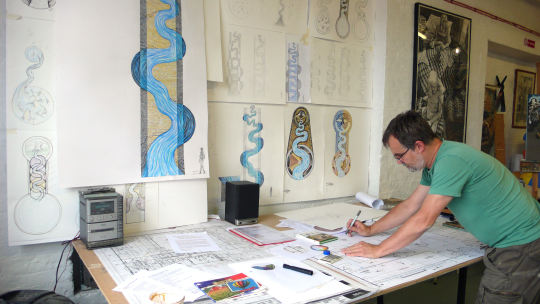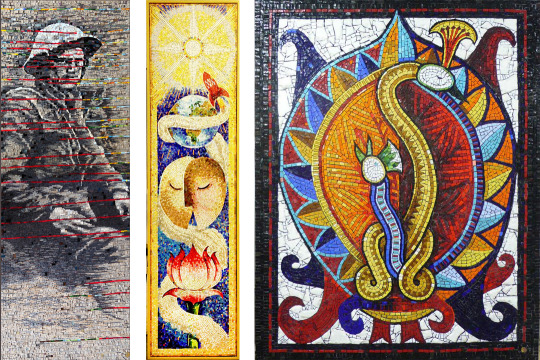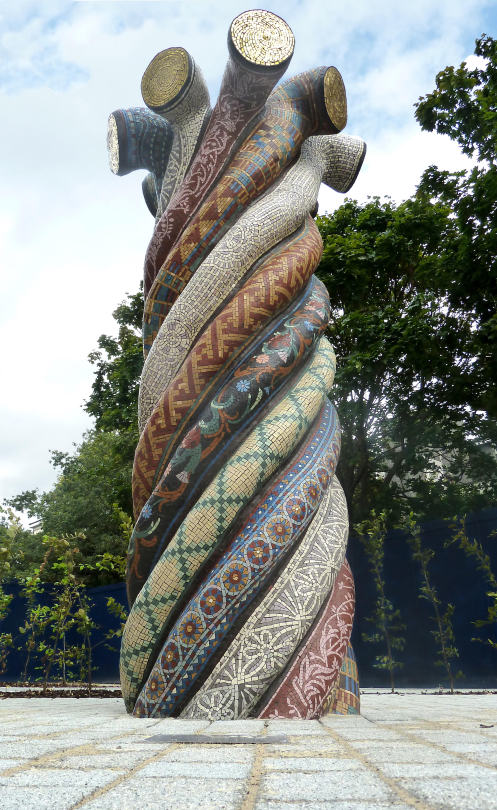#artist of the week

Coffee & Bull’s blood




My latest creations I worked on for the past couple of months finally seeing the light of day.
1. Royal Journey
2. Pink lotus
3. Voices in my head
4. Emancipation is my catharsis

February 14th

Splits
Medium: watercolor painting on watercolor paper
I wanted to be an artist ever since I was a toddler. I think that I am interested in conveying my ideas in any way possible and the visual medium is the best and most direct way I can find expression. After High School, I was in school at Tyler School of Art, I studied both glass and Art History. I always looked at those two disciplines as separate fields. I did the History degree because I thought that was where my career would flourish the most, while the BFA degree was only for the experience; I really enjoyed art-making but never thought I was good enough at it to be able to create a successful career out of my artwork. However, as I went though art school and began to find my way, I gained confidence in myself and realized that maybe I DID have what it takes to pursue my studio practice. When comparing my older work to my more recent, I find that now, my work seems to utilize my research and knowledge of art history as a major part of my research and ideas. When I first started studying glass, I was very inspired by the surrounding city of Philadelphia. Today, I still glean many of my ideas and materials from the urban environment - but my concepts are a little less about city life and more about religion, history, and architecture (as learned from my studies in Art History). I find that my work is enhanced through incorporating my other knowledge and interests outside of glass itself.

GlassRoots) What other materials would you like to work with?
Morgan Gilbreath) I currently work with most any material I can get my hands on, especially found materials. A few years ago, I was making work with dust and dirt from the floors of sites of worship (collected by my feet). My major material goal would be to procure some of the dust from inside of the Kaaba (the black box at the Grand Mosque in Mecca, Saudi Arabia) during the one time a year that the Kaaba is opened and a high priest cleans/dusts the interior room using only a peacock feather. This; along with visiting Mecca (a Muslim-only city) are among some of my loftiest goals for accumulating source materials (both physical and conceptual) for my artwork.

G) Do your sketch your ideas?
M.G.) Yes, I often sketch my ideas as a form of planning and organizing. I also take TONS of notes and do a lot of writing. As artists and makers, I find it very important and helpful to write extensively of your work.
G) How do you find inspiration and avoid artist block?
M.G.) When I encounter artist’s block, I go for a walk in the city. Usually, something seen or something found on the ground during the walk will inspire a new idea for my studio practice. It is also important to have some physical movement (rather than just sitting in your studio) to help ideas come to you. I also overcome artist’s block by going to the library. Researching and looking through random books always help inspire works. Museums, too!
Five years ago, I think that I was very preoccupied with creating meaning and intention in my work. Everything in my work - including color, quantity, and size - had to be symbolic, significant, and metaphorical. I was so obsessed with clearly expressing my ideas that, sometimes, my personal aesthetic (and experimentation) seemed to take a backseat. Now, I am a little less self-conscious about my (still very intentional) creations. No need to over think, just go with your instinct and be true to yourself. As a creative, I think that one of my biggest struggles is my anxiety and stress. Because I am so passionate and driven, I rarely allow myself time off. And when I do, I’m usually preoccupied with the guilt I feel for NOT working every moment of the day. My goal for this upcoming year is to try and focus on enjoying and developing my personal life OUTSIDE of my studio practice and focusing on my well-being and personal happiness beyond my career. I find this is a problem that many dedicated artists encounter and it is important to remember (I keep telling myself this): it is important to have time in which you are NOT working, simply re-thinking, re-grouping, reflecting, and relaxing. It will rejuvenate you so that you can go back into the studio more focused, energized, and bold. No need to over think, just go with your instinct and be true to yourself.

G) What is the best advice you’ve received as an artist?
M.G.) The best advice I have received came from a lecture by American painter Mark Bradford. When asked what advice he had for young emerging artists he said: “INVEST IN YOUR WORK. Prioritize your work over all other expenses. If you don’t invest in yourself and your work, how can you expect others to do so?” Be responsible with your money. I am a very frugal person who lives simply, but when it comes to creating my work, I spare no expense (within reason, of course)!


G) What would you say best defines your style?
M.G.) I think that my style is defined by the use of found/unconventional materials infused with conceptual significance. The materials lists and the titles and writing surrounding my pieces are a key factor in its meaning.
G) Finish this sentence; My art is mostly likely to…
M.G.) My art is most likely to… take a very long time to make.
G) How would you like your art to be viewed?
M.G.) I would like my art to be viewed as a thesis. A tool to draw connections and provoke thought in a way that brings people together. I hope to provoke discussion and idea exchange between diverse peoples and to challenge myself and others to rethink their approach to the world around them. In the end, my goal is to be happy, challenged, and fulfilled by the artwork that I make and the people who surround me.

G) What advice would you give someone considering entering your field?
M.G.) I would advise them that the glass field is a MAJOR sacrifice with MAJOR rewards. It is difficult to maintain a “normal” lifestyle (due to lots of travel and jumping between jobs - and freelance is sometimes required) and it is endlessly hard work. However, if you are passionate about it, there is no other option. The positive thing about the glass world is that everyone surrounding you is as crazy dedicated and passionate as you are, so it breeds a group of incredibly supportive peers and friends.
GlassRoots would like to give a very special thank you to Morgan Gilbreath for allowing us to highlight her work and answering all of our questions! If you’re interested in learning more about Morgan or viewing the rest of her works visit the permanent collection at the Museum of American Glass at Wheaton Arts in Millville, NJ, her website and or purchase an original Morgan Gilbreath original (small-scale) product at morgangilbreath.bigcartel.com.
The now President of The British Association for Modern Mosaics and regular guest lecturer at the Chicago Mosaic School didn’t make it nearly thirty years of creating mosaics without pushing himself to try harder than he did on previous works. The growing catalog of work by Gary Drostle has placed mosaic sculptures and other public artworks in Chicago, California Colombia, Chile and many other places in our big green world! Former hospital muralist and attic mosaic artist Drostle now works out of an old warehouse building that doubles as his home. Beautiful light floods its large north facing windows allowing for an almost perfect workspace. However his living space is unofficial and always under threat of closure making any stability hard to find and just so happens to be one of the things Gary finds most challenging as an artist.

“In our present society there are two aspects where artists face immense difficulties that should be given support, these are housing and workspace. Both of these are linked to income and there are a number of ways that artists can be supported. I think the provision of affordable housing and studio space is a crucial issue, especially somewhere like London where I live, where property prices are beyond the means of most people. Currently there is a discussion about introducing a ‘Citizen Wage’, I strongly believe that this could transform the lives of artists, as well as many other people, and start a new era in cultural richness for our world.” -Gary Drostle
GlassRoots) Complications with stability can cause distractions to just about anyone but we’re curious to know how you stay inspired in spite of that?
Gary Drostle)“I do think looking for inspiration can be a block in itself, it’s better to just get on with it. For me the location of new work is the starting point. Investigating the site, its history, its geography, its people looking at these will usually bring up an interesting story that I would like to pursue; in this way I see myself as telling or retelling a story. So I usually start work at 10am spending the first couple of hours answering emails and doing general business paperwork (if I am not careful sometimes this can fill the whole day). Usually after the emails are done I will either then do some design work (usually with a rough sketch) or carry on working on a mosaic construction.”

Gary Drostle studied fine arts at Camberwell then St. Martins and finally Hornsey College of Art in the graduating class of 1985.
GlassRoots)Do you remember why you started creating?
Gary Drostle)“I do believe that as children we all begin creative. As we get older most will either stop because they are not interested or they just give up because the struggle becomes too hard. So the question really should be when did you stop being creative?”

GlassRoots)What advice would you give someone considering becoming a mosaic artist?
Gary Drostle)“I think the advice I would give would be to remember you are doing this because you love it, (if you don’t you are in the wrong job). Keep the love by making sure you give yourself time, time to rest and enjoy the fact that you are your own boss, take a day off and visit a gallery or just do something else, don’t let the work overtake you.”
GlassRoots)Who are your favorite artist and how have they inspired you?
Gary Drostle)“Karen Ami is one of my favourite contemporary mosaic artists. I also take a lot of inspiration from ancient and aboriginal art, my favourite place is the British Museum in London which houses wonderful collections of Celtic, Saxon, Native American, Inuit, Roman, Egyptian and Persian artifacts.”

Mosaic are defined as a picture or pattern produced by arranging together small colored pieces of hard material, such as stone, tile, or glass. Mosaics can be created using a variety of materials including stone, glass and most recently; digitally. The earliest known mosaics were created using pebbles as tesserae in 8th century BC. This pebble technique, used for both pavements and walls, was later greatly refined by Greek craftsmen during the 5th century. They were able to create intricate designs, using pebbles between one and two centimeters in diameter. Outlines were created with tiny black pebbles, and by the 4th century, colored stones painted red and green were added for greater variety, helping Greek artists to produce complex geometric patterns as well as detailed scenes of people and animals.
GlassRoots) Where can people experience your work?
Gary Drostle)“Most of my commissioned works are in public places; parks, schools, hospitals and town centres. Creating your own voice and having control over your own life through creating art is the most rewarding thing about creating for me. Placing my works in areas like this was a deliberate decision I took right at the beginning of my career, to place my work in the public realm and away from the closed gallery system.”


